Posted 03 May 2009: We both would like to congratulate you to your wonderful service of maintaining the Prabhupadanugas.eu website. It is very well done and we’ll try to be more online from now on to read all the articles. Everything looks very first-class and I am sure Srila Prabhupada is very much pleased with your great endeavour. It is very enlivening and we are very thankful that you provide this platform for all of us. Thank you also for publishing our article. We would like to bring to your attention an interview with Locanananda Prabhu about Sankirtan performance:
![]()
 Effective Sri Sankirtana
Effective Sri Sankirtana
Posted by Locanananda dasa, Apr 30 2009, NEW YORK: Interviewer: Prabhu, you’ve been engaged in street Sankirtana in places like Paris, Amsterdam, Tel Aviv, Geneva, London and New York for nearly forty years. Are there any other points you want to raise about making the Harinam party more effective?
Locanananda dasa: There are three things that come to mind, and they are basically reminders of our roots and ways by which we can please Srila Prabhupada by following in his footsteps. The first recommendation I would like to make is that devotees focus more on chanting Srila Prabhupada’s tune in kirtana. This is the melody His Divine Grace always chanted at public appearances. It is the tune the public is most familiar with and the easiest to learn. Srila Prabhupada even said we could copyright his singing of this tune. Devotees have gotten into the habit of switching from one tune to another every five minutes, but that is not how we were trained by Srila Prabhupada to perform kirtana.
Nowadays, when devotees chant Srila Prabhupada’s melody on Sankirtana, or in temple kirtana for that matter, they repeat it three times and then move on to the next melody. That really surprises me because if instead they would chant Prabhupada’s tune continuously, they would very soon experience transcendental ecstasy.
When we perform kirtana, we want to meditate deeply on the pure sound vibration of the Mahamantra. Jumping around from one tune to another is not at all conducive to becoming absorbed in a profound devotional mood. In fact, it can be downright agitating for the mind. Just ask yourself the following question: “If Srila Prabhupada chanted this tune at almost all public programs, why should I not follow his example?” This makes even more sense when you consider that most Harinam parties only last an hour or two, and therefore switching tunes again and again is not really necessary. As for our Times Square Harinam Sankirtana party, about 90% of our chanting is Hare Krishna Mantra, and about 90% of our chanting of Hare Krishna Mantra is Prabhupada’s tune. Of course, that’s not a rigid formula, but it sure makes for some great kirtana! And we always chant the Panca-tattva Mantra before chanting Hare Krishna to invoke the blessings of Lord Caitanya
and His associates.
Srila Prabhupada had a dream, and in his dream there were chanters and drinkers, and while the chanters were performing kirtana, the drinkers were becoming chanters. When asked if any chanters were becoming drinkers, he said, “Chanters never become drinkers,” and I was asking myself why that was. The answer is that chanters are already intoxicated from drinking the nectar that is contained within the Holy Name of Krishna, and that is especially true for those who mainly chant Srila Prabhupada’s favorite tune.
Interviewer: I understand you are not very fond of the djembe drums that are being played more and more in kirtana these days.
Locanananda dasa: The sound of the mrdanga, which is an expansion of Lord Baladeva, creates auspiciousness, just like the sound of the conchshell. Mahanidhi Swami has written about this in his book, Appreciating Navadvipa Dhama. He also mentions that the sweet sound of the mrdanga is very dear to the Lord. One of our great acaryas, Srila Bhaktivinoda Thakur, says that hearing the kind of kirtana that is ordained by Lord Gauracandra makes his heart dance in ecstasy. As Lord Caitanya’s Sankirtana pastime is eternal, so is the presence of sri mrdanga in the Lord’s kirtana party.
This djembe drum has been around for about 1,000 years. According to Wikipedia, it first appeared when a Djinn presented it to a female Genie as a gift. A Djinn is defined as a malevolent demigod or evil spirit. The djembe is also called the Devil Drum. Animal skins are used to make the head of the drum, and these skins come mainly from slaughtered goats, but also from zebra, antelope or the calf, but never from a mature cow. How much different this is from the story of the mrdanga’s origin. According to the pastime recounted in Mahanidhi Swami’s book, when Krishna was preparing to descend as Lord Caitanya to inaugurate the Sankirtana movement, His flute pleaded, “May I accompany you?” Krishna agreed that the flute may appear as sri mrdanga, and its sweet sound would always be heard in kirtana. So I say, “Fie unto those who are attempting to cover the sound of the mrdanga by bringing in drums not ordained by Sri Caitanya Mahaprabhu. Fie
unto you!”
Srila Prabhupada was asked about adding such instruments to the kirtana. He pointed out that many different musical instruments were present in the world when Lord Caitanya appeared (for example, the djembe), but He chose not to make use of them, and neither should we. There are particular mantras one may recite before beginning to play the mrdanga, but that is not the case for these lower mode Devil Drums. Why on earth would one want to drown out the sound of the mrdanga, which is capable of enchanting the hearts of the devotees, with a sound emanating from the lower modes of nature? I recently heard they are beginning to manufacture these drums on our land in Mayapur. Who has authorized this? I’m sure it was never recommended by Srila Prabhupada.
What Srila Prabhupada did suggest was that we produce the fiberglass drum, now known as the Balarama mrdanga. Just days before I left Amsterdam in 1977 to open a temple in Tel Aviv, the fiberglass drum we had ordered for our preaching program arrived from Los Angeles, along with a Fairchild projector. Srila Prabhupada said the drum was 90% perfected. Not by coincidence, but just a few moments ago, I received a call from Jitarati prabhu in Manila. He informed me that a fully perfected fiberglass Gaura Nitai drum he is having manufactured in the Philippines will soon be made available through Krishna Culture. Srila Prabhupada once suggested that 2,500 fiberglass mrdangas could be sold each year, and that may now come to pass thanks to Jitarati prabhu’s efforts. I can’t wait to play a prototype of the new drum at Times Square when Jitarati prabhu comes to New York for Rathayatra.
So, as much as possible, devotees should become expert mrdanga players. If you can play mrdanga, lead a kirtana, give a class and cook a feast, you can go anywhere in the world and open a center for Krishna. Add to that the art of selling our books and knowing how to perform artik to the Lord and you are a full-fledged Vaisnava capable of representing the disciplic succession. What we need to do is recapture the missionary spirit of spreading this movement. That will not happen unless Harinam Sankirtana is revived.
Srila Prabhupada wrote to Jayapataka in 1969, “Sankirtana is the tried and proven method of propagating all aspects of our Krishna consciousness movement, so continue to go out chanting in the streets as much as possible.” He also wrote to Brahmananda that the Africans should learn to play the mrdanga. He did not say that we should introduce worldwide African drum-playing into our performance of Sankirtana. Nor did Srila Prabhupada himself or any of the predecessor acaryas play the djembe in kirtana. To the contrary, Gour Mohan De had his son take lessons on the mrdanga to prepare him for his great mission in life – to spread Krishna consciousness to every town and village in the world in fulfillment of Lord Caitanya’s prophecy.
Interviewer: You have mentioned chanting Prabhupada’s tune and getting rid of the non-devotional drums that are affecting the quality and purity of our kirtana. What is the third item?
Locanananda dasa: That would be to once again make Back to Godhead magazine a monthly publication available for mass distribution. I don’t think our movement has been the same since we made BTG a bi-monthly periodical that is sold by subscription only. During Srila Prabhupada’s lifetime, that would never even have been contemplated by anyone because of the sacred trust between spiritual master and disciple to perpetuate his legacy without change. Srila Prabhupada said publishing Back to Godhead was his first service to his spiritual master, and he instructed that the magazine should be printed monthly, even if only one page. He also said it was the backbone of our movement and that it should be distributed as widely as Reader’s Digest. At one point, in New York City devotees were distributing 100,000 copies monthly, and now… practically none. Srila Prabhupada wanted distribution of books and magazines to double every year, but since then, BTG
sales have decreased by 99%.
The Back to Godhead magazine was a great source of inspiration for the entire movement. I still remember how each new issue would be offered in front of Radha Govinda on Henry Street, and devotees would tear open boxes of magazines and fly out the door to distribute them. I remember one devotee in Amsterdam named Akhiladhara prabhu who would fill his bookbags with 200 Back to Godhead magazines and not return to the temple at night until they had all been sold. That’s the kind of excitement that was generated by having the Magazine of the Hare Krishna Movement available for mass distribution.
By handing out magazines around a kirtana party, future book distributors were being born. Young devotees were learning how to deal with interested people and to present our exalted Vaisnava philosophy to the public in the simplest terms. Back to Godhead magazine was always one of the main instruments used to inform the world about the devotee lifestyle. Srila Prabhupada insisted that it include numerous pictures of devotees chanting. Srila Prabhupada also said that every man had a quarter in his pocket with which to purchase Back to Godhead, and that there would always be a market for our books and magazines. He said that every time a person would turn the corner, a devotee should be there with a magazine to place in his hand. Meanwhile, ISKCON artists were producing glorious paintings depicting the pastimes of Radha and Krishna that astounded BTG readers. Srila Prabhupada wanted his disciples to write for the magazine as part of their training. So
much did he treasure Back to Godhead magazine that Srila Prabhupada said the articles in our magazine would one day be taken as Vedic evidence!
Why was the change made from mass distribution to subscription only? Once again, market forces were at work. The thinking of those in power had nothing to do with following the standard set by the spiritual master or with preserving his legacy. It was all about profit calculation. Temples could buy small books for less than they would have to pay for a magazine, and devotees could also get a bigger donation for a small book. “So let’s just sell small books on Sankirtana so we can make more profit, and people who are willing to pay the price will purchase a subscription to Back to Godhead. So what if BTG sales drop from 500,000 a month to 5,000 a month. We will have more money to run the temples, so it’s worth the sacrifice.” I guess they didn’t include the enthusiasm factor, the devotee-making factor, or the following-the-wishes-of-the-
I encourage everyone to get involved in this Sankirtana movement, to chant publicly for the benefit of the fallen conditioned souls, and to distribute transcendental knowledge in the form of Srila Prabhupada’s books. I thank you for the opportunity to share this message with devotees throughout the world.
The next two installments of this interview will suggest to the GBC a new approach to dealing with legal challenges as well as suggestions to resolve the debate over initiation protocols.


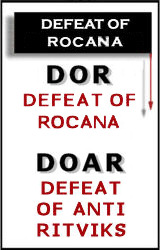
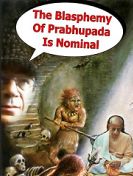
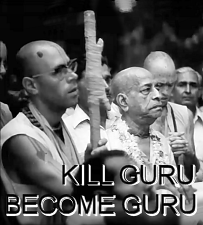
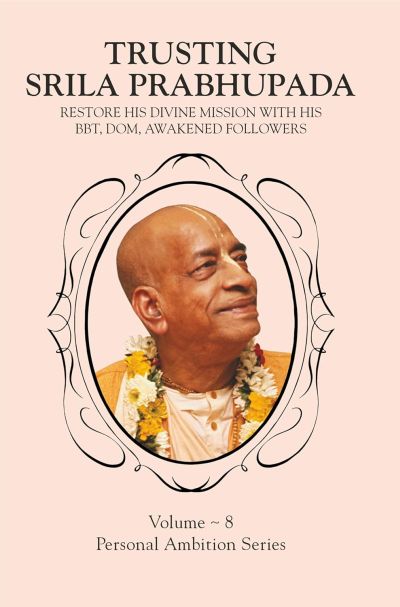
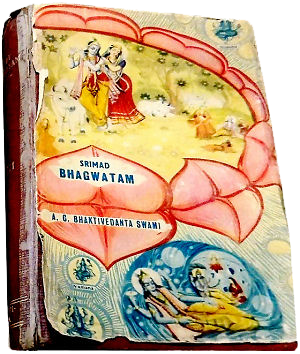
Speak Your Mind